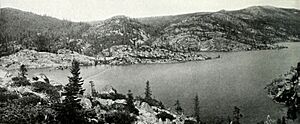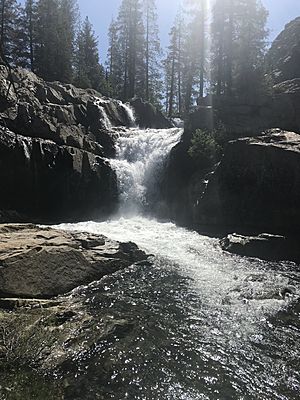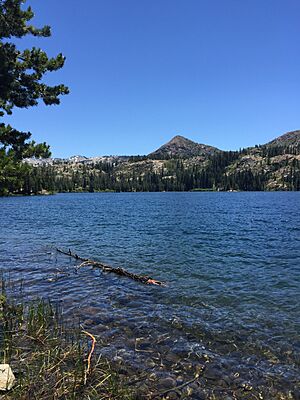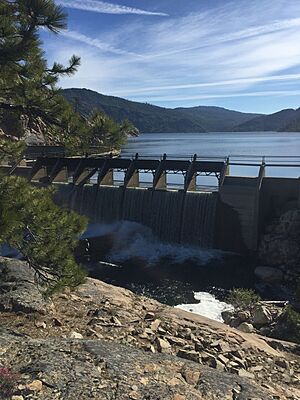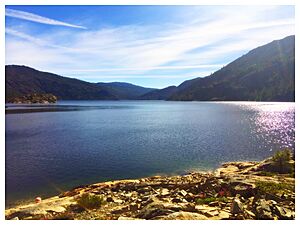Yuba–Bear Hydroelectric Project facts for kids
The Yuba–Bear Hydroelectric Project is a big system that creates electricity using water power in the northern Sierra Nevada mountains in California. It uses water from the upper parts of the Yuba River and Bear River. This project covers about 400 square miles (1,036 square kilometers) across Nevada, Placer, and Sierra Counties.
The Nevada Irrigation District owns this project. It includes 16 large dams that store water, plus many smaller dams that help move water around. There are also four power stations that make 425 million kilowatt-hours of electricity every year. The Yuba–Bear Hydroelectric Project is made up of several main parts: the Bowman, Dutch Flat No. 2, Chicago Park, and Rollins developments.
Contents
How the Project Started
The Yuba–Bear project began in 1962 when people in the Nevada Irrigation District voted to build it. Construction started in 1963 and finished in 1966. It cost about $65 million back then. Later, in the 1980s, the Rollins Dam and Bowman power plants were added. This project brought new canals, more places to store water, and the ability to make electricity. It also added 145,000 acre-feet of water storage for local residents.
Rivers and Their History
The Yuba River Story
The Yuba River flows through very old rocks, including those formed millions of years ago. Over time, these river channels filled with gravel, large rocks, and sand that were rich in gold.
The Yuba River was greatly changed by gold mining in the past. Even today, you can see effects like old mines, mercury left in the riverbed, and changes to how sand and gravel move through the river. Besides gold, other important minerals like copper and tungsten were found here. In 1994, mining for gravel and sand became more important than gold mining. The Yuba River still carries a lot of sediment, mostly mining gravel, because of the intense hydraulic mining that happened long ago.
The Bear River Story
The Bear River flows through a deep, V-shaped canyon. This suggests that a much larger river once flowed here, and glaciers also helped shape the land. The Bear River was also heavily affected by hydraulic mining and still has mercury pollution from the gold rush.
The Bear River starts in the Tahoe National Forest. It has three main parts: the Upper, Middle, and Lower Bear River. The biggest lake in the Bear River area is Camp Far West Reservoir. The Bear River flows into this reservoir before joining the Feather River. The Bear River is a popular spot for fishing, especially for brown and rainbow trout.
How the Project Works
The main water sources for this project are the Middle Yuba River and Canyon Creek. Jackson Meadows Dam holds water from the Middle Yuba. This water is then sent south through a special pipe called the Milton-Bowman Diversion Conduit into Bowman Lake. Bowman Lake is a reservoir on Canyon Creek. Besides Jackson Meadows and Bowman, the project also gets water from fourteen smaller lakes high in the Sierra mountains, which have been dammed to make them bigger.
After passing through the Bowman Powerhouse, the water continues south to Lake Spaulding. This lake is part of another big water project called the Drum-Spaulding Hydroelectric Project, owned by PG&E. Lake Spaulding is on the South Yuba River and is a very important spot because almost all the water used by both projects passes through it.
Below Lake Spaulding, water flows through canals of the Drum-Spaulding Project into the upper Bear River. Here, it powers six hydroelectric plants as it flows downhill to Rollins Reservoir. Rollins Reservoir is the lowest main reservoir of the Yuba–Bear project. The Yuba–Bear project runs two of these power plants (Dutch Flat No. 2 and Chicago Park), plus a smaller one below Rollins Dam.
The Federal Energy Regulatory Commission considers the Yuba–Bear project, along with the Drum-Spaulding Project, to be "the most physically and operationally complex hydroelectric project in the United States." This means it's one of the most complicated water and power systems in the country!
Parts of the Yuba–Bear Project
The Nevada Irrigation District (NID) got the license for the Yuba–Bear project in June 1963. This license was set to be renewed in April 2013. The project has 13 main dams and can store a total of 207,865 acre-feet of water. It also includes 4 powerhouses, 4 water pipes, a 9-mile-long power line, and places for recreation.
Bowman Development
The first part of the Yuba–Bear project is the Bowman development. It starts with the Jackson Meadows Dam on the Middle Yuba River. This dam creates the Jackson Meadows Reservoir, which is man-made and covers 1,054 acres. It can hold 69,205 acre-feet of water. The Jackson Meadows Reservoir Recreation Area has 282 camping sites.
Further downstream is the Milton Main Diversion Dam and Milton South Diversion Dam, which create the Milton Reservoir. This reservoir covers 103 acres and holds 295 acre-feet of water. There's also Jackson Dam on Jackson Creek, which creates Jackson Dam Lake. This lake covers 58 acres and holds 1,330 acre-feet of water. Jackson Creek Campground has 13 camping sites.
Other important lakes in the Bowman Development are on Canyon Creek. These include French Lake (13,940 acre-feet), Faucherie Lake (3,980 acre-feet), and Sawmill Lake (3,030 acre-feet). Faucherie Lake Recreation Area has 25 campsites.
Bowman Lake is formed by Bowman North Dam and Bowman South Dam on Canyon Creek. Bowman Lake covers 820 acres and can hold 68,510 acre-feet of water. The Bowman Powerhouse and its power lines start here, connecting to the Drum-Spaulding Project. Bowman Campground has 10 camping sites.
Dutch Flat No. 2 Development
Water reaches the Dutch Flat Development through the Bowman-Spaulding Conduit. This system moves water from Canyon Creek below Bowman Lake through long flumes, canals, and tunnels. Other dams on Texas Creek and Fall Creek also send water into this conduit. The Dutch Flat No. 2 Conduit takes water from PG&E's Drum-Spaulding Project and sends it to the Dutch Flat No. 2 Forebay. This forebay is a reservoir next to the Bear River, covering 8 acres and holding 185 acre-feet of water. The Dutch Flat No. 2 Powerhouse then uses this water to make electricity.
Chicago Park Development
Six miles upstream from where the Bear River meets Rollins Reservoir is the Dutch Flat Afterbay Dam. This dam creates the Dutch Flat Afterbay reservoir on the Bear River, which covers 140 acres and holds 2,037 acre-feet of water. From here, the Chicago Park Conduit uses flumes and ditches to carry water to the Chicago Park Forebay Dam. This dam creates the Chicago Park Forebay, another reservoir next to the Bear River, covering 7 acres and holding 117 acre-feet of water. The Chicago Park Powerhouse then generates electricity.
Rollins Development
This part of the project includes the Rollins Dam on the Bear River and Rollins Reservoir. The reservoir covers 825 acres and can hold 65,989 acre-feet of water. Rollins Reservoir also has 332 camping sites across 4 campgrounds. The Rollins Powerhouse uses water from the reservoir to complete this project.
Other Connected Projects
Drum–Spaulding Project
The Drum-Spaulding Project is closely linked with the Yuba–Bear project and is run by PG&E. It includes several power plants like Drum No. 1 and No. 2, Spaulding No. 1, No. 2, and No. 3, Dutch Flat No. 1, Halsey, Wise, Wise No. 2, Newcastle, and Deer Creek. These plants all generate electricity.
Yuba River Development Project
The Yuba River Development Project is run by the Yuba County Water Agency and is also connected to the Yuba–Bear Hydroelectric Project. This project includes the New Bullards Bar Reservoir on the North Yuba River, two smaller dams (Our House Diversion Dam and Log Cabin Diversion), and three powerhouses (New Colgate, Fish Release, and Narrows No. 2). It also has various recreation facilities and can generate 361.9 megawatts of electricity.
What the Project is Used For
When working at its fullest, the Yuba–Bear project can generate 79.32 megawatts of electricity. This power is sold to Pacific Gas and Electric (PG&E). The project's reservoirs can store a total of 203,865 acre-feet of water.
Besides making electricity, the project also greatly increases the amount of water flowing in the Bear River. This extra water is the main source for the Nevada Irrigation District's irrigation system, helping to water farms and homes.


